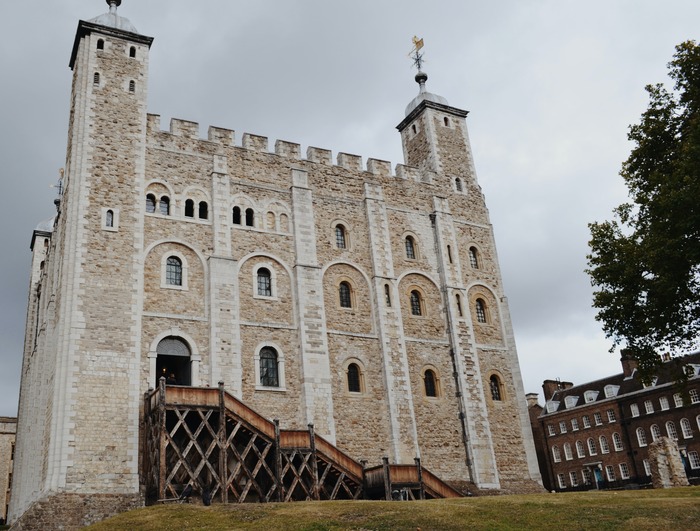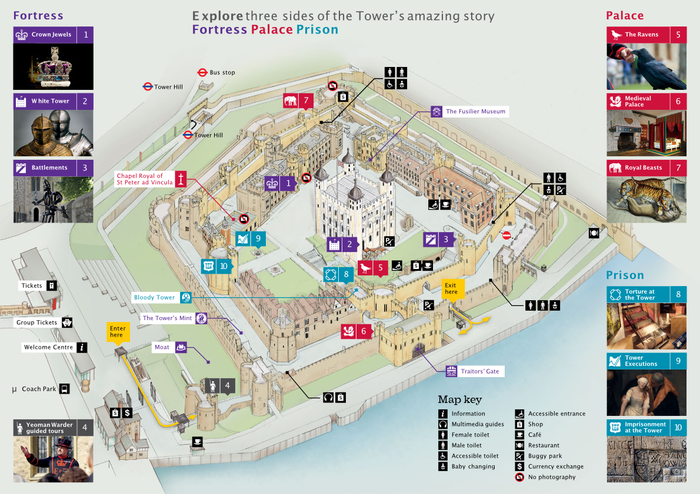
What to see at the Tower of London?
The Tower of London is a historic fortress located in the center of the English capital, on the north bank of the Thames, next to the famous Tower Bridge.
The Tower of London was listed as a UNESCO World Heritage in 1988.
History of the Tower of London
The construction of the Tower of London began in 1066 as part of the Norman conquest of England.
It is a complex made up of several buildings surrounded by two concentric defensive walls and a moat.
advertisement
The White Tower - central building of the Tower of London - was built on the order of William the Conqueror in 1078, a symbol of the oppression inflicted on London by the ruling class. A fourth level was added to it in the XVth century.
In the 12th and 13th centuries, under the reigns of Richard I, Henry III and Edward I, the fortress experienced several expansion phases. The plan established at the end of the 13th century did not evolve any more.
The Tower of London has played a pivotal role in the history of England. Besieged on several occasions, used as a prison and place of torture from 1100 (until after the Second World War), it also served as royal residence, treasury, armory and menagerie and also hosted the Royal Mint (until the second half of the XIXth century) and the public archives. Today it houses the collection of British Crown Jewels.
The first Norman castles were generally built of wood, but by the end of the 11th century many of them - including the Tower of London - were renovated with stone.
Visit the Tower of London
The Tower of London is a place steeped in history - recognized as one of London's top sights.

Allow at least half a day for the visit.
The Tower of London is managed by the Historic Royal Palaces - a recognized non-profit association which receives no government or crown support and is funded by entrance fees and donations.
The Crown Jewels
The exhibition "Crown Jewels" presents the sacred and ceremonial objects of the royal family: crowns, costumes, swords and scepters of inestimable material, historical and religious value.
This collection of 23,578 gems and objects is one of the favorite attractions of visitors!
In 1669, the Jewel House - built during the reign of Henry III to house the Crown Jewels - was destroyed and the jewels were moved to the Martin Tower (1669-1841) - then known as the Tower of Jewels. Talbot Edwards, the first keeper of the tower, was the victim in 1671 of the first attempt to steal the jewels by Thomas Blood and his accomplices.
It is advisable to start your visit with this exhibition in the morning, when it opens.
Photos are prohibited inside this building.
The White Tower

The White Tower corresponds to the central building of the Tower of London. It is the oldest part of the building. Inside is the collection of royal armor used under Henry VIII, Charles I and James II - as well as the royal arsenal.
Many animations and interactive activities are also offered.
The Medieval Palace
The Medieval Palace is a reconstruction of the royal apartments with some remains of furniture dating from the time when the fortress was used as royal palace for the king and the queen.
Beefeaters: the Tower guards
The Tower guards - called Beefeaters or Yeomen Warders - are dressed in black and red uniforms. The inscription "EIIR" (for Elizabeth II Regina) on the front of their costume designates the current monarch: the Queen Elizabeth II.
Originally, their role was to monitor prisoners held in the Tower of London and to ensure the protection of Crown Jewels. Today, they mainly provide guided tours of the fortress.
These guards are recruited from former members of the British armed forces. They must have at least 22 years of service and be holders of the Medal for Long Service and Good Conduct. There are currently 37 of them.
Your entrance ticket to the Tower of London includes the "Yeoman Warder Tour”: a guided tour - approximately 1 hour - by a Beefeater.
The ravens of the Tower
The other celebrities of the Tower of London are its legendary ravens: officially 6 in number (but 7 in reality - in case one of them would escape!) - they are usually positioned on the South Lawn and are considered the Guardians of the Tower of London.
The legend says if the 6 ravens were to disappear, the Tower would collapse along with the Kingdom.
The Ravenmasters are in charge of the surveillance and protection of these birds.
The 7 ravens are named Jubilee, Harris, Gripp, Rocky, Erin, Poppy and Merlina.
The tips of their wings are cut off to prevent them from escaping.
The royal beasts
From 1200 to 1835, the Tower of London was home to many exotic animals: tigers, lions, elephants - and even a polar bear!
These animals were gifts from other kingdoms or relics of wars.
These animals were subsequently transferred to London Zoo.
Of this menagerie today only statues and an exhibition retracing its history remain.
The Bloody Tower
Better known as the Bloody Tower, the Lower Wakefield Tower of the Tower of London is home to the exhibition "Torture at the Tower" which presents the different methods, instruments and tools of torture used in the past to punish or make prisoners talk.
It was in the XVIth century, following the assassination of the young princes Edward and Richard in the tower that it was nicknamed the Bloody Tower.
The Tower prison
The Tower of London is also known to have been a prison during the two world wars.
The Beauchamp Tower houses an exhibition on the famous prisoners of this prison (Queen Elizabeth I, Queen Anne Boleyn, Baron William Hastings, Queen Jane Gray, writer Thomas More, Guy Fawkes, etc.): the rooms where they were imprisoned and the various texts they carved on the walls of their cells.
The Royal Chapel of St Peter-Ad-Vincula
Built in 1520, the Chapel Royal of St Peter and Vincula is the place where the bones of the most famous prisoners who were executed are kept.
Today, the chapel remains the place of prayer for the 150 people who live in the tower.
Map of the Tower of London

Plan a half-day (around 4 hours) visit to discover all of the Tower of London's attractions and exhibitions.
advertisement
Tickets for the Tower of London
The ticket price for the Tower of London includes access to most of the shows and activities.
Compare the prices of our partners to find the cheapest ticket to visit the Tower of London:

Admission is included in the London Pass.
Tower of London opening hours
The Tower of London is open all year round:
- From March to October:
- Tuesday to Saturday 9:00 a.m. to 5:30 p.m.
- Sunday and Monday from 10:00 a.m. to 5:30 p.m.
- From November to February:
- Tuesday to Saturday 9:00 a.m. to 4:30 p.m.
- Sunday and Monday from 10:00 a.m. to 4:30 p.m.
Getting to the Tower of London
The Tower of London is located in the City district at St Katharine's & Wapping, EC3N 4AB, London.
To get there, 2 options:
- Tube: Circle, District lines and DLR, Tower Hill stop.
- Bus: lines 8, 9, 11, 15, 15B, 22B, 25, 133 and 501.
Close to the Tower of London
Take advantage of your visit to the Tower of London to visit:
- The HMS Belfast
- London City Hall
- The Monument
- The Shard
- The Tower Bridge